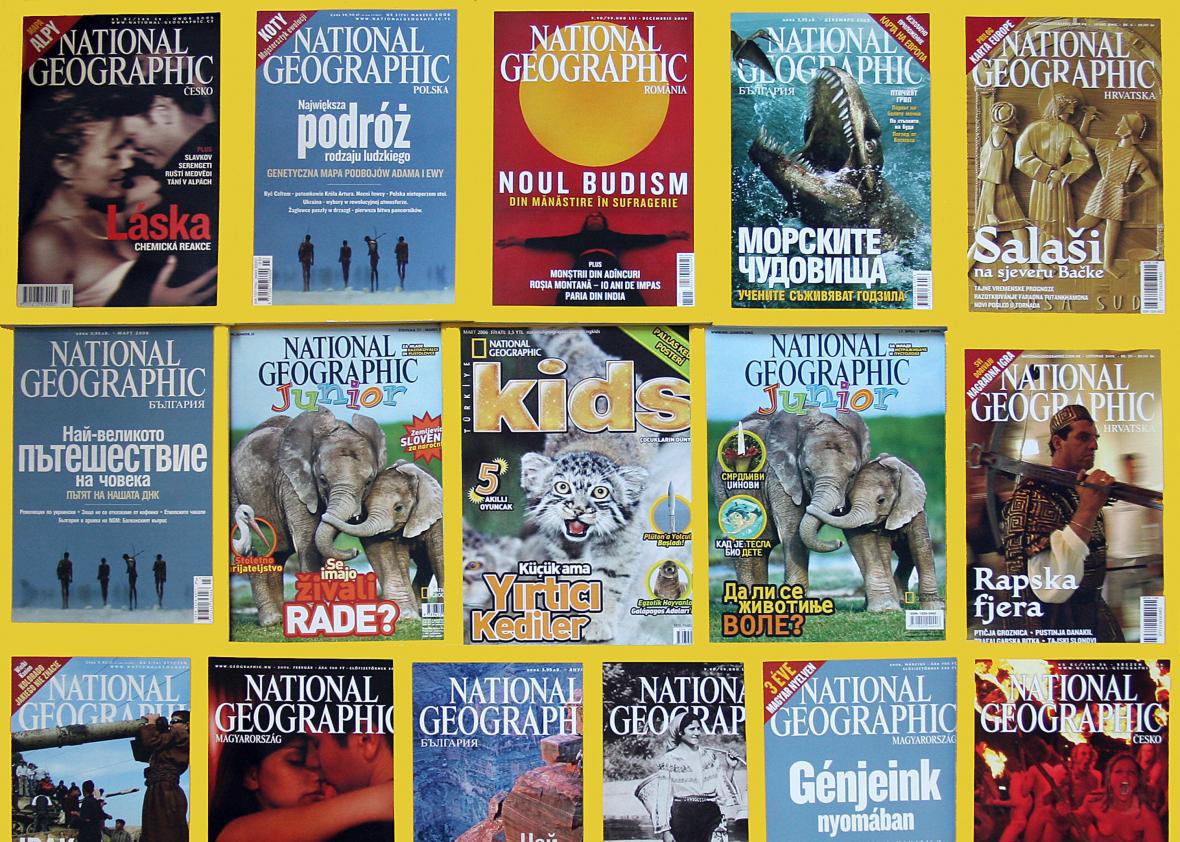In 1898, the prestigious National Geographic Society was run by Alexander Graham Bell. As of this week, its storied media brands* are effectively owned by 21st Century Fox. On Wednesday, the two announced their union as National Geographic Partners, a for-profit organization that will encompass the society’s cable TV channels; digital properties and publishing operations; maps and other media; and, yes, the iconic wildlife and photography magazine. As part of a $725 million deal, Fox will hold a 73 percent stake in the new venture, and provide some much-needed financial life support for a magazine whose finances have been on a steady decline in the digital era.
For many of us, the end of National Geographic’s media operations as nonprofit entities raises some uncomfortable questions: Now that it essentially belongs to one of the biggest entertainment companies in the world, will the name National Geographic still signal the same sense of beauty, wonder, and scientific rigor? Will it still inspire children to become researchers, inventors, and explorers? Will they still thumb through its goldenrod spines, searching for their favorite issue on the dietary habits of African lions? After all, this is the magazine that funded and published the work of Jane Goodall, photographed Jacques Cousteau’s first undersea explorations, and supported the work that resulted in today’s marquee discovery of a new human hominid by researcher Lee Berger. With this merger, will National Geographic remain the same voice for conservation, adventure, and wanderlust we know and love?
I called up Robert Poole, executive editor of the magazine until 2001 and author of Explorers House: National Geographic and the World It Made, to ask what readers can expect from a for-profit enterprise run by the Rupert Murdoch–founded media conglomerate that brought us such marvels as Celebrity Boxing and Who Wants to Marry a Multi-Millionaire? “For most of its history, National Geographic was owned by nobody,” he told me. “There were no stockholders. There was no stock. The asset was not held by any individual, but by the board of trustees. That’s why the magazine could afford to do ridiculous things, like send a camera crew with the first American expedition to Mount Everest in 1963. They had this mission, and it was very clear what the mission was: to tell stories, to educate people about ‘the world and all that was in it.’ All of those things are because it was independent. It’s no longer independent.”
Will the loss of independence strike a blow to the magazine’s distinguished brand and quality? “I don’t think there’s any question about it,” Poole said.
Current employees of the magazine are more hopeful. Fox has partnered with National Geographic Channels for 18 years now, a union that has elicited worries from Poole and others that the magazine’s content is being influenced by its broadcasting cousin (as well as spawned such quality programming as Wicked Tuna). But that’s not exactly the case, I was told by an editor at National Geographic who asked not to be named. “The TV side does exert a pull now, but it’s largely in the form of coming to the magazine for story information, so that they can create TV content that spins off from magazine content,” the editor told me. “I’ve never been pressured into doing a story because it will tie into something on the channel.” The editor added that, in the wake of the Fox deal, Fox and National Geographic executives assured the staff that they would maintain their editorial independence.
“The editors at National Geographic are committed to accurate reporting of science, and we would never let those standards slip,” the editor said.
News of the $725 million partnership came as a surprise even to the magazine’s higher-ups, who found out the details of the expanded partnership in a meeting just a few days ago. Yet editor-in-chief Susan Goldberg says she isn’t worried. “Obviously, it was a big change,” she told me. “It’s sort of a lot for people to take in at once. But as we’ve digested the information, there are lots of us who are really excited about it. It’s pretty hard to have your voice heard these days. This will give us the reach and scale we really need to cut through the clutter.”
“I couldn’t be more pleased,” Goldberg added.
When asked whether any of the staff were concerned that that voice might change, Goldberg said, “not at all.” Instead, what fans can expect is “more and more alignment with our television partners on work that is core to our brands.” The most recent episode of National Geographic Channel’s rebooted series Explorer, for instance, is directly tied to the magazine’s September cover story on how Africa’s illegal ivory trade fuels terrorism on the continent.
Let’s clear up one thing. On Wednesday, media outlets such as Boing Boing intimated that a company founded by Murdoch—who doesn’t understand and has outright denied climate change—would bode disaster for the National Geographic Society’s prestigious grant program, which currently doles out about 250 grants a year to scientists around the world, estimated at $15,000 to $20,000 each. This is not so. Instead, the partnership creates a separate for-profit that houses the media outlets, leaving the society as a nonprofit including the grants and education arms, according to Nat Geo. The partnership will actually double the size of the society’s endowment and increase its ability to fund scientists, says Goldberg. (Also worth noting: 21st Century Fox’s day-to-day operations are now headed by Rupert’s son James Murdoch, whose wife works for the Clinton Climate Initiative.)
More research money can only be good for science. However, as Poole points out: “The question is, what strings are attached to this money coming from Fox? What do they get in return?” We’ll see.
Update Sept. 10, 2015: This article ihas been updated to clarify that Fox will effectively own National Geographic’s media brands, not the National Geographic Society.
